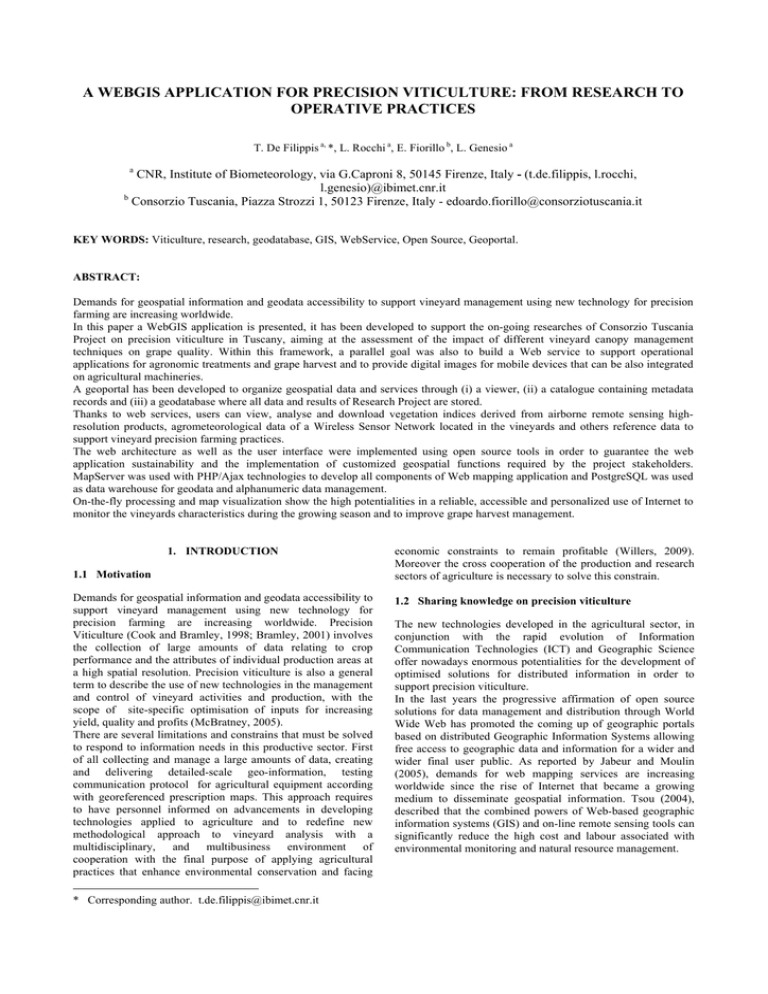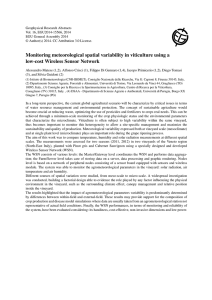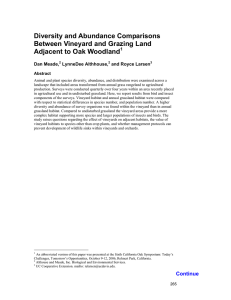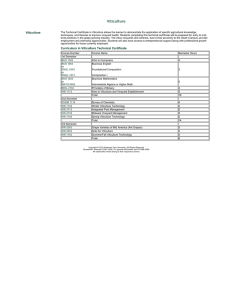A WEBGIS APPLICATION FOR PRECISION VITICULTURE: FROM RESEARCH TO OPERATIVE PRACTICES
advertisement

A WEBGIS APPLICATION FOR PRECISION VITICULTURE: FROM RESEARCH TO OPERATIVE PRACTICES T. De Filippis a, *, L. Rocchi a, E. Fiorillo b, L. Genesio a a CNR, Institute of Biometeorology, via G.Caproni 8, 50145 Firenze, Italy - (t.de.filippis, l.rocchi, l.genesio)@ibimet.cnr.it b Consorzio Tuscania, Piazza Strozzi 1, 50123 Firenze, Italy - edoardo.fiorillo@consorziotuscania.it KEY WORDS: Viticulture, research, geodatabase, GIS, WebService, Open Source, Geoportal. ABSTRACT: Demands for geospatial information and geodata accessibility to support vineyard management using new technology for precision farming are increasing worldwide. In this paper a WebGIS application is presented, it has been developed to support the on-going researches of Consorzio Tuscania Project on precision viticulture in Tuscany, aiming at the assessment of the impact of different vineyard canopy management techniques on grape quality. Within this framework, a parallel goal was also to build a Web service to support operational applications for agronomic treatments and grape harvest and to provide digital images for mobile devices that can be also integrated on agricultural machineries. A geoportal has been developed to organize geospatial data and services through (i) a viewer, (ii) a catalogue containing metadata records and (iii) a geodatabase where all data and results of Research Project are stored. Thanks to web services, users can view, analyse and download vegetation indices derived from airborne remote sensing highresolution products, agrometeorological data of a Wireless Sensor Network located in the vineyards and others reference data to support vineyard precision farming practices. The web architecture as well as the user interface were implemented using open source tools in order to guarantee the web application sustainability and the implementation of customized geospatial functions required by the project stakeholders. MapServer was used with PHP/Ajax technologies to develop all components of Web mapping application and PostgreSQL was used as data warehouse for geodata and alphanumeric data management. On-the-fly processing and map visualization show the high potentialities in a reliable, accessible and personalized use of Internet to monitor the vineyards characteristics during the growing season and to improve grape harvest management. 1. INTRODUCTION 1.1 Motivation Demands for geospatial information and geodata accessibility to support vineyard management using new technology for precision farming are increasing worldwide. Precision Viticulture (Cook and Bramley, 1998; Bramley, 2001) involves the collection of large amounts of data relating to crop performance and the attributes of individual production areas at a high spatial resolution. Precision viticulture is also a general term to describe the use of new technologies in the management and control of vineyard activities and production, with the scope of site-specific optimisation of inputs for increasing yield, quality and profits (McBratney, 2005). There are several limitations and constrains that must be solved to respond to information needs in this productive sector. First of all collecting and manage a large amounts of data, creating and delivering detailed-scale geo-information, testing communication protocol for agricultural equipment according with georeferenced prescription maps. This approach requires to have personnel informed on advancements in developing technologies applied to agriculture and to redefine new methodological approach to vineyard analysis with a multidisciplinary, and multibusiness environment of cooperation with the final purpose of applying agricultural practices that enhance environmental conservation and facing * Corresponding author. t.de.filippis@ibimet.cnr.it economic constraints to remain profitable (Willers, 2009). Moreover the cross cooperation of the production and research sectors of agriculture is necessary to solve this constrain. 1.2 Sharing knowledge on precision viticulture The new technologies developed in the agricultural sector, in conjunction with the rapid evolution of Information Communication Technologies (ICT) and Geographic Science offer nowadays enormous potentialities for the development of optimised solutions for distributed information in order to support precision viticulture. In the last years the progressive affirmation of open source solutions for data management and distribution through World Wide Web has promoted the coming up of geographic portals based on distributed Geographic Information Systems allowing free access to geographic data and information for a wider and wider final user public. As reported by Jabeur and Moulin (2005), demands for web mapping services are increasing worldwide since the rise of Internet that became a growing medium to disseminate geospatial information. Tsou (2004), described that the combined powers of Web-based geographic information systems (GIS) and on-line remote sensing tools can significantly reduce the high cost and labour associated with environmental monitoring and natural resource management. 1.3 Aims The aim of present study was to create a common web-based framework were different actors can share data, research results and advanced knowledge on viticulture and oenology. In this paper we present a WebGIS application developed to support the on-going researches of Consorzio Tuscania Research Project in Tuscany (Central Italy) aiming at the assessment of the impact of different vineyard canopy management techniques on grape quality. The project has been also set to comprehensively investigate the pedo-climatic and agronomic variables that can influence the final product. For this reason for each vineyard, a characterization of the different vigour index areas was carried out; afterwards, inside each vigour block, experimental parcels were defined and characterized by a combination of different agronomic treatments (leaf removal from the six basal nodes, different levels of bud load, cluster thinning). The experiment is conducted in renown areas for wine production on vineyards planted to cultivars Sangiovese and Cabernet Sauvignon, both with the same plant density (2m x 0.8m) and canopy architecture (single curtain). Several Research Institutes, involved in the Project, are carrying out, each year, physiological surveys, remote sensing and proximal sensing analyses as well as productive analyses on grapes. Farmers and wine grower are also involved in research activities sharing their agronomic knowledge and supporting the experimental field activities. Within this context, a parallel goal was to build a web service to support the operational applications for agronomic treatments and grape harvest and to provide digital image for mobile devices that can be also integrated on agricultural machineries. It should also be highlighted that the technological profile of farmers has changed and improved in the last ten years and that the diffusion of geobrowser (e.g. Google Earth) and mobile devices are facilitating the transfer of know-how from research on spatial data integration to operational practices with the obvious and consequent advantages of a distributed georeferred information on web. technologies to manage all client-side components as well as events, results and user interactions. All georeferenced maps related to study area are stored into a PostgreSQL/PostGIS DBMS and are processed by MapServer. This open source tool, was developed by University of Minnesota (Mapserver, 2010) and contains a library of functions for the construction of maps that can be used in CGI (Common Gateway Interface) scripts. In this web application the requests by user’s Web browser goes to the application’s Web server, which sends the parameters necessary to display the maps to MapServer. MapServer generates the map and sends it back to the web server, which transmits it to the user’s web browser (Mitchell, 2005). Several programming languages use functionalities that interact with MapServer’API (Application Programming Interface). This project use the PHP MapScripts wrapper as web programming language to directly interact with the MapServer’API to access and manage spatial data. The main web services implemented in this application include a WMS and a metadata catalogue. WMS (Web Map Server) is one of the Internet map servers and image servers communication protocol standard indicated by Open GIS Consortium (OGC) for Web-based GIS. WMS Implementation Interface Specifications provides guidelines for current image-based Internet map servers with the specifications of HTTP contents and Uniform Resource Locators (URLs) communication syntax (OGC, 2002). 2. METHODOLOGY 2.1 System architecture The system architecture was designed to support the research activities through WebGIS applications finalized to share results with scientific community, decision-makers and/or other stakeholders that work in viticulture sectors. The client/server architecture proposed (Figure 1), as well as the user interface, has been implemented using open source tools in order to guarantee the web application sustainability and the implementation of customized geospatial functions required by the research project. geographical database and The framework developed for this precision viticulture research project is composed by a WebGIS application (WGViewer), a GeoDataBase (GeoDB) and a metadata calalogue. WebGIS application has been developed using PHP/Ajax technologies and based on KaMap 0.2, an Open Source project to create Ajax (Asynchronous JavaScript e XML) interfaces for Web-mapping applications (ka-Map, 2010). The WGViewer GUI (Graphical User Interface) with analysis and querying functions are completely customizable using a system database through which the application is able to work with different profiles and datasets. The GUI has been developed using AJAX Figure 1. System architecture 2.2 Geographical Database One of the goals of this project is to provide a useful, geographically coherent, multi-source and site-specific data base to support the ongoing research on precision viticulture carried out by the Consortium partners. The GeoDataBase is the real core business of system architecture. It is a relational database designed to store, query, and manipulate geographic information and spatial data. The primary advantage of spatial databases, over file-based data storage, is that they allow implementing geospatial functions and GIS procedures. This includes support for SQL and ability to generate complex geospatial queries. Moreover a database's client/server architecture supports multiple users and allows them to view, edit, and query the database without conflict. For the purposes of research project, the GeoDB has been implemented using PostgreSQL and its extension PostGIS. PostgreSQL is an object-relational database management system released under a BSD-style license, and is thus free and open source software. PostGIS adds support for geographic objects to PostgreSQL object-relational database. In effect, PostGIS "spatially enables" the PostgreSQL server, allowing it to be used as a backend spatial database for Geographic Information Systems. PostGIS follows Simple Feature Specification for SQL as OGC Standard; it was developed by Refractions Research (2010) as Open Source Spatial Data Base and it was released under GNU General Public Licence. The geodatabase for precision viticulture researches is composed by four sub-databases and it’s fed by both geographical and alphanumeric data from different sources and formats. In this version raster data have been stored outside PostgreSQL/PostgGIS Database, they have been allocated into the file system in their original raster formats. All these data are managed by the database management through an engine codesystem that allows relations between the different elements stored. The geographical information mainly consists of digital cartography and remote and proximity sensing images provided by research partners as well as field data collection in the parcels, results of quality control samples. 2.2.1 Data modeling Conceptual design of the database is based on the entityrelation model; a participative approach with the research partners involved in data collection and analysis has been adopted for application schema implementation. UML (Unified Modeling Language) as formal language adopted in the ISO TC/211 context for geomatic data description has been used for formal data sets definition. UML model (Figure 2) of main data domains was generated using Enterprise Architect (EA) case tool of © Sparx System. Adoption of an application schema allows to update, modify and integrate easily the GeoDB during the different phases of research project. Moreover UML is platform independent, and can facilitate implementation procedures of physical database. More than 9000 plants over experimental plots of the four vineyards are monitored; all the yearly collected and analysed data micro-scale level are related with airborne images, soil parameters, vineyard geography. all’Adige, Trento). Ground data collection was carried out every year following a previously defined experimental design. Chemical analyses were performed on grapes (musts and peels) to determine several wine quality parameters like pH, °Brix, total acidity, anthocyans and poliphenols at technological ripening and two weeks later (late vintage). Similarly a huge amount of sub-daily agro-meteorological parameters (temperature, rainfall, wind speed, etc..) is monitored by a wireless sensor network. All these analytical data are here stored in specific tables linked to geographic features (vector data) by relations allowing spatial queries. The whole structure of GeoDB has been built to support georeferenced queries and data retrieval for advanced statistical analysis of site-specific measurements with the potentiality to expand the relations with new data for new research goals. 2.3 Meteorological data flow Each experimental vineyard is equipped with the NAV (Advanced Vineyard Network) system, a wireless sensor network designed and developed with the aim of remote realtime monitoring and collecting of micrometeorological parameters in a vineyard (Matese, 2009). The NAV system includes, for each experimental vineyard, a base station (Master Unit) and a series of peripheral wireless nodes (Slave Units) located in the vineyard. The Master Units (MU) are typical single-point monitoring stations placed outside the vineyard and collect data for the whole vineyard. Slave Units (SU) are multiple stations placed in the vineyard with specific sensors for monitoring and storage of site-specific agro-meteorological data; they use wireless technology to transmit daily collected data to the master unit (MU). Each MU sends daily about 15.000 data stored to the remote central server using the GSM/GPRS device. An acquisition sub-system was developed in order to supply a high security level for data quality to be stored into GeoDB. This structure makes web-server isolated and protected by unauthorized access. It is a Java based application composed by two modules. The first one is installed in the external server that receives meteorological data by GSM modem and provides real time control checking for data errors and consistency before sending agro-meteorological data to data server via FTP connection. The second module is installed on the data server, it always runs as a “demon” and looks for new incoming data from the first module; when new data are incoming, an ETL (Extract Transform Module) stores the data into the GeoDatabase. It also supplies a log system with automatic feedback by email to the system administrator. 2.4 Airborne remote sensing and image processing Figure 2. UML diagram of experimental vineyards. Physiological and productive analyses are carried out each year by different Research Groups involved in the research Project. Ground samples were collected for each experimental parcel by researchers of Fondazione Edmund Mach (San Michele One of the most powerful tools in precision viticulture is the use of airborne remote sensing though its ability to rapidly provide a synoptic view of grapevine shape, size and vigour over entire vineyards (Hall, 2003). In the Consorzio Tuscania Research Project image acquisition is carried out three times per year, in a period between June and September, which comprises important phenological stages like flowering, fruit set and veraison. Airborne remote sensing is performed with SKY ARROW 650 TC/TCNS airplane. Airborne images are acquired with Duncan Multispectral Camera MS4100 (1920x1080 RGB colors CCD); they have 30 cm spatial resolution and record visible and near infrared bands. Images, radiometrically and geometrically corrected, were processed in order to derive Normalized Difference Vegetation Index (NDVI) (Rouse, 1973) maps. 2.5 Proximal sensing A new way to monitor vineyards in precision viticulture is quickly spreading by the use of quad-vehicles. This kind of vehicle offers the advantage of low exercise costs and more flexibility of use not being influenced by meteorological conditions. In the Tuscania Research Project, the Dipartimento di Produzione Vegetali (DIPROVE) of University di Milano tested a quad-vehicle equipped with photosynthetically active biomass and ultrasonic sensors in order to obtain respectively NDVI and canopy thickness maps (Carnevali, 2009). Figure 3. Soil, NAV system and airborne visible images of experimental vineyard. 2.6 Soil sensing It has been proved that the spatial variation in soil characteristics can be associated with the spatial variation in vine characteristics within the vineyard. New soil nodestructive soil mapping techniques are based on electromagnetic induction (EMI) sensors mounted on quadvehicles. An EMI sensor measures the bulk electrical conductivity of the soil and by interpolation it is possible to derive several kinds of maps useful for decision makers, like texture, field capacity, plant availability water and saturation maps. More than 30 soil maps related to the experimental vineyards are stored in raster format and available for integrated analysis. First research results on variability of NDVI and its correlation with grape quality parameters (Fiorillo, 2009), as well as derived prescription maps, have been distributed on web for operative applications finalized to support mechanic grape harvest and agronomic treatments. 3. RESULTS 3.1 Geoportal components Geoportals are gateways to spatial information providing integrated access to knowledge, including maps, applications, geographic webservices, analytical models, reports, as well as related text material (Maguire, 2005). Many geoportals are focused on specific application domains. Geoportal developed for this precision viticulture research project (http://www.consorziotuscania.it) emphasizes user-oriented services, distributed network environments, metadata standards, communication protocols, client/server computation, and ubiquitous access. It is composed by three main components: the viewer, the data catalogue and the geodatabase. Restricted permission are defined for different users profiles in accord to project data policy on data acquisition, data management, access and use. Figure 4. Normalized Difference Vegetation Index (NDVI) Vine vigour is reported to have a considerable effect on fruit yield and quality (Fiorillo, 2009; Dry, 2000; Haselgrave, 2000; Petrie, 2000; Tisseyre, 1999); NDVI (Figure 4) is a vegetation index able to effectively detect the different vigour areas present in vineyards. Prescription maps (Figure 5) are filtered and classified NDVI maps (in order to homogenize the vigour areas) that can be interpreted by special devices mounted on agricultural machineries. To each detected vigour area, a value indicating different quantities of fertilizers or pesticides or different classes of grape quality at vintage can be assigned. 3.2 Map Viewer WGViewer is the viewer developed for this web application and it is able to utilize both vector-based and raster-based on a single view. Thanks to web services users can view and analyze updated parameters, indices derived from airborne remote sensing high-resolution products and reference data to support vineyard precision farming researches. Additional thematic maps useful for spatial analysis (DEM, hydrography, administrative units etc.) of the study areas are also provided. Thus, available cartography includes different layers of information that can be combined to generate customized maps and facilitate holistic approach in research studies and vineyard management (Figure 3). Figure 5. Prescription map of Donna Olimpia vineyard. Prescription maps are an essential tool for the application of precision viticulture in the modern agricultural mechanization. In fact farmers require new information to reduce fertilizers, pesticides and herbicide for the environmental sustainability of viticulture. The interface supplies a lot of analysis functions and measurement tools. For this specific application, an advanced query system was developed; it is able to perform a spatial query on single points (identify function) or on area drawing a box on the screen viewer (Figure 6). The web application connects PostgreSQL using Mapserver and runs directly the requested query on the GeoDatabase. The WebServer creates a result page on the fly showing all retrieved information using a customized GUI. A pop-up window will be created to show the result page on the same screen (Figure 7). Data catalogue (Figure 8) and search engine was developed using Ajax technology (for client-side application) and PHP language (for server-side service). GUI was implemented with ExtJS, an Ajax development library. By mean of this interface users are able to perform research for data, documentation and metadata, download all geographical data in their original format (compressed .zip files), view a quick look for geographical data, view documents (pdf, doc and excel formats) and metadata. Currently, ISO 19115 Metadata Standard is the international metadata standard adopted for this application. The major advantage of ISO 19115 is its flexibility in creating extensions and profiles for various applications. Well-documented data can so guarantee a right information use and data traceability for research studies. MU SU Figure 6. NAV system: query on Master Unit Figure 8. Data catalogue 3.4 GeoDataBase connection The GeoDataBase can be accessed and queried through the stand-alone application pgAdmin, the most popular and feature rich Open Source administration and development platform for PostgreSQL, and through others Client-side GIS applications (e.g.: QGIS, GRASS). A user-friendly interface (Figure 9) for agro-meteorological queries is also under development in order to support no-expert users in SQL language. Figure 7. Results of spatial query on NAV points: real – time meteorological data (graphics or tabular representation) The web application is able to supply data through WMS standard protocol. All client-GIS software with WMS capabilities can access to GeoDatabase and retrieve required data using HTTP link to WMS service. Moreover WGViewer supplies a WMS Tool in order to connect with external GeoDatabase using WMS protocol. 3.3 Catalogue Catalogue is a web application that supplies a search engine for fast data retrieving helping users in research information. Four major functions were provided by the data the catalogue implemented: metadata display, data preview, data download, and metadata search/index. These functions provide an easy to use mechanism for stakeholders to access or download GIS data and remotely sensed images that can be readily combined or integrated with their own local GIS software projects. Figure 9. Customized query interface for agro-meteorological database. The richness of this large geodatabase implies a large research potential based on data integration, whose images were demonstrated to be a powerful tool for research and monitoring of vineyard (Silva et al., 2009). 4. CONCLUSIONS Data acquisition, access and distribution as well as the model of how information is used in agriculture, open a new way in precision viticulture to improve the product quality in terms of environmental sustainability of agriculture and natural resource management. By implementing dynamic Web mapping services, farmers, producer and researchers can access geographic information and high resolution remotely sensed data using a typical desktop computer without installing expensive GIS and remote sensing software packages. The bet is also to build a web service to support the operational applications during the grape harvest and to provide digital images for mobile device that would be also integrated on farm machines. Moreover future developments of this web applications are addressed forward a full customizable GUI with statistical and data correlation tools, dynamic data loading system and multi-user system, analysis function to support new vineyard management practices for operative use. Further research on distributed GIS applications are addressed towards the interoperability between geographic standard formats and protocol ISO/FDIS 11783 and its XML data transfer files. ACKNOWLEDGEMENTS The development of the GeoDB and Web-GIS application was carried out with the support of the “Consorzio Tuscania” Project. The authors thank Stefano Di Blasi, Manuel Pieri (Consorzio Tuscania). Thanks to IASMA Fondazione Edmund Mach of San Michele all’Adige and Diepartimento di Produzione Vegetali (DIPROVE – University of Milan) for cooperation, help and assistance about respectively grapeproduction data and proximity sensing images. Alessandro Matese (IBIMET-CNR) and Filippo Di Gennaro (Consorzio Tuscania) for NAV system management and support in agrometeorological data modeling. REFERENCES Bramley, R.G.V., 2001. Progress in the development of precision viticulture – Variation in yield, quality and soil properties in contrasting Australian vineyards. Precision Tools for Improving Land Management. Eds. L.D. Currie and P. Loganathan. Occasional report No. 14, pp. 25-43. Carnevali, P., 2009. Continuous proximal sensing mapping tools for determining vineyards variability. Proceeding of 16th International GiESCO Symposium, July 12-15, University of California, Davis, pp. 317-321. Cook, S.E., Bramley, R.G.V., 1998. Precision Agriculture Opportunities, Benefits and Pitfalls. Australian Journal of Experimental Agriculture 38, pp.753-763. Dry, P.R., 2000. Canopy management for fruitfulness. Australian Journal of Grape and Wine Research 6, pp. 109115. Fiorillo, E., Genesio, L., Maselli, F., De Filippis, T., Gioli, B., Toscano, P., 2009. Mapping the spatial variability of vineyard canopy using high-resolution airborne multispectral images Proceeding of 16th International GiESCO Symposium, July 1215, University of California, Davis, pp. 19-24. Hall, A., Louis, J., Lamb, D.W., 2003. Characterising and mapping vineyard canopy using high-spatial-resolution aerial multispectral images. Computers & Geosciences, 29: 813-822. Jabeur, N., Moulin, B. A., 2005. Multiagent-based approach for progressive web map generation. On the Move to Meaningful Internet Systems 2005: OTM 2005 Workshops, Proceedings Lecture Notes in Computer Science, 3762, pp. 99-108. Ka-Map 1.0 - Documentation retrieved from http://kamap.maptools.org/ (last access date : May 10, 2010) Maguire, D. J. and Longley, P., 2005. The emergence of geoportals and their role in spatial data infrastructures. Computers, Environment and Urban Systems. 29, pp. 3-14. Mapserver. Documentation for the Mapserver project, Retrieved from: http://www.mapserver.org/ (last access date: May 7, 2010). Matese, A., Di Gennaro S.F., Zaldei A., Genesio, L., Vaccari F.P., 2008. A wireless sensor network for precision viticulture: The NAV system. Computers and Electronics in Agriculture 69, pp. 51–58 McBratney, A., Whelan, B., Ancev, T., Bouma, J., 2005. Future directions of precision agriculture. Precision Agriculture 6, pp. 7-23. Mitchell, T., 2005. Web Mapping Illustrated: Using Open Source GIS Toolkits. O’Reilly, Sebastopol, CA. Open GIS Consortium, Inc. (OGC) 2002. OpenGIS Web Map Server Interface Implementation Specification (Version 1.1.1). Open GIS Consortium, Inc., Wayland, Massachusetts, URL: http://www.opengis.org/techno/implementation.htm (last access date: May 18, 2010) Petrie, R.P., Throught, M.C.T. and Howell, G.S., 2000. Fruit composition and ripening of Pinot Noir (Vitis Vinifera L.) in relation to leaf area. Australian Journal of grape and Wine Research 6, pp. 40-45. Refraction Research. What is PostGIS? Retrived from: http://postgis.refractions.net/ ( last access date: May 20, 2010). Rouse, J. W. Jr., Haas, R. H., Schell, J. A., Deering, D. W., 1973. Monitoring vegetation systems in the great plains with ERTS. The 3rd ERTS Symposium, NASA SP,351 (1) pp. 309317. Silva, P.R., Ducati, J.R., 2009. Remote sensing and radiometric techniques applied to vineyards in two regions of Rio Grande del Sul, Brazil. International Journal of Remote Sensing 30(23), pp. 60085-6098. Tisseyre, B., Ardoin, N. and Sevila F., 1999. Precision viticulture: precise location and vigour mapping aspects. Proceedings 2nd European Conference on Precision Agriculture, Sheffield Academic Press, Sheffield, UK, pp.319330. Tsou, MH., 2004. Integrating Web-based GIS and image processing tools for environmental monitoring and natural resource management. Journal of Geographical Systems 6, pp.155-174. Willers, J.L., Jallas, E., McKinion, J., Seal M.R., Turner, S., 2009. Precision Farming, Myth or Reality: Selected Case Studies from Mississippi Cotton Fields. Advances in Modeling Agricultural Systems. P.J. Papajorgji, P. M. Pardalos, (eds). Springer Science, pp. 243- 271.




